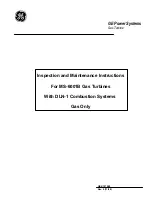
Table 2. PV Array Example
Panel Type
Voc
Vmpp
Isc
Impp
# of
panels
Max
String
Voltages
Power
total
Victron 260W (60 cell)
36.75 V
30 V
9.30 A
8.66 A
#1 - 8
#2 - 8
304 V
4160 W
3.5. Cable connection sequence
First:
Confirm correct battery polarity, connect the battery.
Second:
if required, connect the remote on-off, and programmable relay, and communications cables
Third
: Confirm correct PV polarity, and then connect the solar array (if incorrectly connected with reverse polarity, the PV voltage
will drop, the controller will heat up but will not charge the the battery). Torque: 2,4 Nm
3.6. Connection to the load
Never connect the output of the inverter to another AC supply, such as a household AC wall outlet or AC wave forming petrol
generator. Wave synchronising PV solar inverters can be connected to the AC output, see section on Frequency Shift Function for
more information.
The Inverter RS is a safety class I product (supplied with a ground terminal for safety purposes).
Its
AC output terminals and/or grounding point on the outside of the product must be provided
with an uninterruptible grounding point for safety purposes.
The Inverter RS is provided with a ground relay that
automatically connects the Neutral output
to the chassis
. This ensures the correct operation of the internal earth leakage switch and an
earth leakage circuit breaker that is connected to the output.
─ In a fixed installation, an uninterruptable grounding can be secured by means of the
grounding wire of the AC input. Otherwise the casing must be grounded.
─ In a mobile installation (for example, with a shore current plug), interrupting the shore
connection will simultaneously disconnect the grounding connection. In that case, the casing must
be connected to the chassis (of the vehicle) or to the hull or grounding plate (of the boat).
Torque: 2 Nm
3.7. VE.Direct
Used to connect a PC/laptop to configure the inverter.
3.8. VE.Can
Used to connect to a GX Device.
3.9. Bluetooth
Used to connect to the device via VictronConnect for configuration.
3.10. User I/O
3.10.1. Remote on/off connector
The remote on/off has two terminals: Remote L and Remote H.
A remote on/off switch or relay contact can be connected between L and H. Alternatively, terminal H can be switched by a
connection to battery positive, or terminal L can be switched by a connection to battery minus.
Special case for Victron lithium batteries in combination with the smallBMS. When Lithium is selected in the software, the remote
on/off is changed, and that physical interface instead becomes the connection point for the allow-to-charge and allow-to-
discharge wires.
The remote H input is the connection point for the allow-to-discharge control wire and must to be connected to the Load output of
the smallBMS. The remote L input is the connection point for the allow-to-charge control wire and must be connected to the
Charger output of the smallBMS. Remote on/off function is now taken over by the smallBMS.
Inverter RS Smart
Page 7
Installation
Содержание Inverter RS Smart
Страница 1: ...Inverter RS Smart Rev 03 02 2021 ENGLISH ...
Страница 23: ...7 Appendix Inverter RS Smart Page 21 Appendix ...
Страница 24: ...7 1 Appendix A Connection Overview Figure 2 Inverter RS Front Inverter RS Smart Page 22 Appendix ...
Страница 25: ...Figure 3 Inverter RS Bottom Inverter RS Smart Page 23 Appendix ...
Страница 27: ...7 2 Appendix B Block Diagram MPPT BATTERY 48V PV IN 230 Vac Inverter RS Smart Page 25 Appendix ...









































